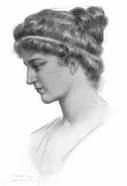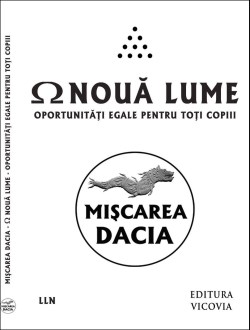 Vă invit să vă alăturaţi grupului Facebook Mişcarea DACIA, ce-şi propune un alt fel de a face politică!
Vă invit să vă alăturaţi grupului Facebook Mişcarea DACIA, ce-şi propune un alt fel de a face politică!Citiţi partea introductivă şi proiectul de Program, iar dacă vă place, veniţi cu noi !
O puteţi face clicând alături imaginea, sau acest link
Archive for Giugno, 2019:
Hyperian History Of The World (5th Century)
Hyperian History Of The World (4th Century)
Hyperian History Of The World (4th Century)
In the Rome of the early 4th Century, the Neoplatonism of Plotinus could easily have become a revolutionary new intellectual form of paganism based on Greek philosophy. Unfortunately, in one of history’s bitterest twists, a new emperor arose in Rome who would sow the seeds for the rise of a new version of Christianity, the version with which we are familiar today, that of irrational faith, violence, hatred and a slave-like morality which puts people down and represses their passions.
It was the Emperor Constantine who, though he lived most of his life as a pagan, in 313 helped to declare religious tolerance for Christianity and, indeed, any other religion in Rome. Prior to this only Roman paganism was accepted by the Romans. Christianity, Judaism and any other religions were illegal across the empire and those practising them were often persecuted. Now, however, all religions could be freely practised throughout the empire without fear of persecution.
This change allowed Christianity to better organise itself, as its practitioners no longer feared for their lives in the practising of their faith. Constantine himself helped immensely to consolidate Christianity into a single religion, rather than a collection of competing sects, when he called the first council of Nicaea in 325. At this council, Christian bishops from all over the world agreed on a single, unified version of their religion which was summed up in the Nicene Creed. It was only at this council that the divinity of Jesus was agreed upon, as well as the doctrine of the trinity, stating that god, Jesus and the holy spirit were all three persons within the one single, monotheistic god. Christianity as we know it today was really born at this council and the new religion was now supported by the might of the Roman Empire.
Though Christianity remembers Constantine as the first Christian Emperor, he remained a pagan right until he lay on his deathbed, only then being converted to the new faith. Historians continue to debate the extent to which Constantine was a true supporter or believer in Christianity or not.
It looked as though Christianity would now take over, given its use of fear to control its adherents. Christians, through fear of their god, were far more easily radicalised than pagans and, as such, the zealous nature of Christianity found little resistance from the more peaceful pagans.
However there was one final, last gasp of paganism later in the century when a new emperor, Julian, came to power in 361. Julian, who had been given a first class ‘Greek’ education, saw that the new values of Christianity were massively at odds with everything which the Roman Empire was founded upon and he feared that this new religion would spell the end of the Empire. As such, Julian rejected Christianity and greatly favoured Neoplatonism instead. He introduced new laws which aimed to block the progress of Christianity and to restore the primacy of paganism within the Roman Empire.
Although it was a valiant attempt to halt the progress of this damaging new religion, Julian was ultimately unsuccessful. The main source of his failure is perhaps the lack of a pagan equivalent of the council of Nicaea. There were so many different pagan sects and cults, each with different beliefs and philosophies, that there was a lack of unity amongst pagans, whereas, thanks to the Nicene Creed, Christians were now unified in their beliefs and practices and could therefore combat paganism as a single unit. Sure enough, upon the death of Julian, Christianity was restored as the state religion of Rome under his successor, Jovian.
The tragedy of the 4th Century, which saw benevolent, intellectual paganism pushed deep underground and replaced by the violent, irrational faith and slave morality of Christianity, shows us how important is the need for Unity. Only if we are united under a single banner, all adhering to the same, rational system, can we ever hope to oppose the might of the Old Worlders. The rise of Christianity plunged the world into a darkness from which it has yet to fully emerge. But the dawn is coming, and if we are all unified together, this fractured world can be repaired and light can be restored.
Brice Merci – Hyperian
Videoconferinţa Mişcării Dacia din 12.06.2019
Hyperian History Of The World (3rd Century)
“Hyperian History Of The World (3rd Century)
In the 3rd Century, the Hellenic world, centred on Alexandria, was awash in various, conflicting sects of Christianity, ranging from those more radical and more Jewish, to those more pagan, such as the Gnostic sects, as well as many other non-christian sects of Greek/Roman paganism. In the previous century, the religious element of these sects had taken precedence over any kind of intellectual, philosophical elements. But in the 3rd century, a great genius appeared in the world who would revive Greek philosophy and combine it with the religious sensibility of the time to produce a truly intelligent and intellectual religion. The Genius was Plotinus and his philosophical religion became known as Neoplatonism.
After travelling to Alexandria seeking philosophical wisdom, Plotinus came across a man called Ammonius Saccas, whose lectures on the philosophy of Plato so affected Plotinus that he immediately began studying under this new teacher. After many years of study under Ammonius Saccas, Plotinus began travelling around gaining further wisdom from Persian, Indian and Arab philosophers before finally settling in Rome towards the end of his life, where he spread his teachings around the great city.
Plotinus’s philosophical religion is basically the philosophy of Plato turned into a religion. Plotinus himself insisted that he was not creating anything new, but was rather producing the culmination of Plato’s philosophy. In the system of Plotinus, everything has its source in what he called The One. The One is essentially the arche, the source of everything. But for Plotinus, The One, as the source of everything, is very similar to Pythagoras’s concept of the point that contains all other points, i.e. The One is purely dimensionless and immaterial, yet contains within it everything else in the universe.
Plotinus’s system consists of a series of emanations starting from The One. The first thing that emanates from The One is The Nous, basically the same Nous as that of Anaxagoras. The Nous is the mind or the intellect of the universe, the thing that guides it and controls it. For Plotinus, the Nous contains within it all of the perfect Forms that Plato had spoken of. As the mind of the universe, the Nous knows everything about the universe and thinks all possible thoughts simultaneously.
The next emanation is the Psyche or the soul, emanating from the Nous. The Psyche is equivalent to Plato’s Demiurge. Whereas the Nous thinks everything simultaneously, the Psyche thinks slowly and as a linear process. The Psyche can access the Forms present in the Nous and use them to create the next emanation which is Nature, or the physical world, which is, as Plato said, an inferior copy of the Forms in the Nous. The Psyche is also split into two parts, firstly the upper part which is the World Soul, the collective soul of the world, and secondly, the lower part which takes the form of all the individual souls in the universe.
As these individual souls are only one emanation away from the physical world, Plotinus explains that these souls take the physical world to be true reality, when, in fact, True reality is mental rather than material, the true Forms in the Nous rather than the inferior copies of them in Nature. For Plotinus, the task of our souls is to leave behind the physical world and travel back up the emanations, firstly to the upper Psyche, or World Soul, then into the Nous itself where the True Forms are, and finally back to The One, which contains everything. This idea expands on Anaximander’s original concept that the universe begins as apeiron and shall return to apeiron.
Unfortunately, Plotinus’s religion, based on reason, rationality and mathematics, as well as the ideas of the greatest of geniuses of Ancient Greece, failed to take hold of Europe which, instead, adopted the absurd, irrational, faith-based version of Christianity which took over the Roman empire.
Of course, it is not too late to abandon the absurdity that is Christianity and revive the brilliant ideas of Plotinus, a religion which would far better have served the Romans and, indeed, the rest of the world. A religion based on reason, philosophy and mathematics is precisely what the world needs right now. The central idea can be summed up by Plotinus’s supposed last words: “Try to raise the divine in yourselves to the divine in the all.” If that’s not Hyperian, I don’t know what is.”
– Azure Circe – Hyperian















